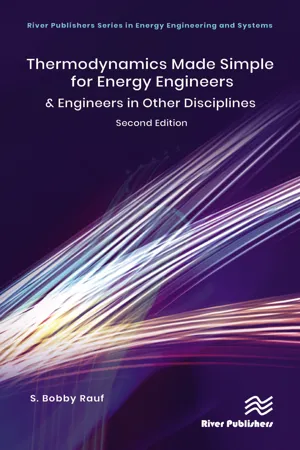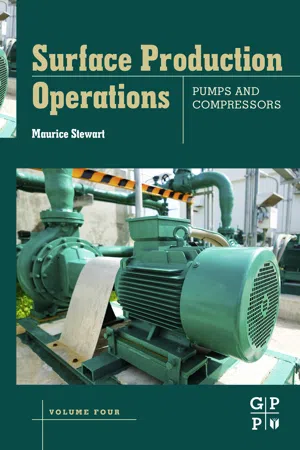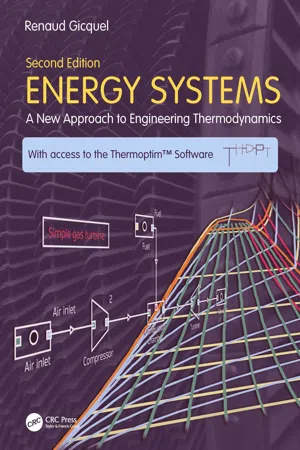Technology & Engineering
Isentropic Process
An isentropic process is a thermodynamic process in which the entropy remains constant. This means that there is no heat transfer and no change in the entropy of the system. In practical terms, an isentropic process is often used as an idealized model for processes such as the compression or expansion of gases in engineering applications.
Written by Perlego with AI-assistance
Related key terms
4 Key excerpts on "Isentropic Process"
- eBook - ePub
Thermodynamics Made Simple for Energy Engineers
& Engineers in Other Disciplines
- S. Bobby Rauf(Author)
- 2023(Publication Date)
- River Publishers(Publisher)
s” stays constant.Figure 8.8 Isentropic Processes in a carnot cycle, an ideal cycle heat engine.8.4.13 Throttling process and inversion point
Throttling process, in a thermodynamic system, is an adiabatic process which consists of a significant pressure drop but no change in the system enthalpy. This significant drop in pressure is sometimes accompanied by significant increase in velocity of the thermodynamics system. Furthermore, in a throttling process, no heat is exchanged with the surrounding and in some cases no work is performed on or by the system. Since the enthalpy in a throttling process stays constant, a throttling process is also an isenthalpic (constant enthalpy) process.In a throttling process:Where,p2 < <p1ΔH = 0, and Δh = 0ΔH = Change in “absolute” enthalpy, measured in BTUs, Joules (J) or kilo Joules (kJ) Δh = Change in specific enthalpy, measured in BTUs/lbm, Joules (J)/ gram or kilo Joules (kJ)/kilogram (kg)In ideal gas systems, throttling processes are constant temperature processes.p2 = Final, lower, pressurep1 = Initial, higher, pressureIn real gas scenarios, temperature change does occur when the gas is throttled. However, for every real gas, under a given set of conditions, there is a temperature point at which no temperature change occurs when the gas is throttled. This temperature is called an inversion point. For air, maximum inversion temperature is 603°K.8.4.14 Thermodynamic equilibrium
A thermodynamic system is said to be in equilibrium when it is in a thermal, chemical, mechanical, convectional and radiative state of balance. A thermodynamic system in equilibrium experiences no thermal, chemical, mechanical, radiative and convectional changes when isolated or insulated from the surroundings. - eBook - ePub
- V. Babu(Author)
- 2019(Publication Date)
- CRC Press(Publisher)
2 , the reduction in kinetic energy required to diffuse the flow to the same exit pressure is less in an Isentropic Process. In other words, for a given decrease in the kinetic energy, the pressure rise is more in an Isentropic Process when compared to an adiabatic irreversible process.EXAMPLE 9.12Calculate the isentropic efficiency of the turbine in Example 9.9.Solution : At the end of an isentropic expansion to the same exit pressure, P2s= 10 bar and s2s= s1 = 6.5404 kJ/kg.K. From Table B , with sf = 2.1387 kJ/kg.K and sg = 6.5861 kJ/kg.K, it is clear that, state 2s is in the mixture region. The dryness fraction may be evaluated asx=2 s= 0.9897s−2 ss fs g−s fFrom Table B , with hf = 762.8 kJ/kg and hg = 2777.7 kJ/kg, the specific enthalpy at state 2s, is given asTherefore, the isentropic efficiencyh=2 sh f+x(2 sh g−h f) = 2756.95 k J / k gη t== 0.89h 1−h 2h 1−h2 sEXAMPLE 9.13Calculate the isentropic efficiency of the compressor in Example 9.10.Solution : At the end of an isentropic compression process to the same pressure, we have P2s= 700 kPa, s2s= s1 = 0.9345 kJ/kg.K. This is a superheated state. From Table F , we can retrieve h2s= 269.45 kJ/kg after interpolation. Therefore, the isentropic efficiencyη c== 0.71h−2 sh 1h 2−h 1EXAMPLE 9.14Calculate the isentropic efficiency of the nozzle in Example 9.11.Solution : At the end of an isentropic expansion process to the same pressure, we have P2s= 1 bar, s2s= s1 = 7.5273 kJ/kg.K. This is a superheated state. From Table C , we can retrieve h2s - Maurice Stewart(Author)
- 2018(Publication Date)
- Gulf Professional Publishing(Publisher)
The differences can be attributed to differences in heat transfer (cooling). The isothermal process would require continuous cooling during compression to negate the entire temperature rise. It is never commercially possible to remove the heat of compression as rapidly as it is generated. Thus, this process is not as logical a working base as the adiabatic although it was used for many years. Compressors are designed for as much heat removal as possible. In an actual compressor the theoretical isentropic discharge temperature can sometimes be achieved by a moderate amount of cooling during compression. Even so, the resultant process will not be purely isentropic due to other losses in an actual machine. The polytropic path BC best represents an actual process where there is no cooling during compression.In practice, the isentropic and polytropic methods of analysis are both usable for designing and predicting the performance of compressors.The adiabatic process occurs when there is no heat added or removed from the gas during compression. In practice the isentropic (adiabatic) process is commonly applied to positive displacement compressors, both reciprocating and rotary, since these machines are often equipped with a cooling system that cools the casing or cylinder during compression, making the actual temperature rise approach that of the theoretical adiabatic process.The polytropic process is a modification of the adiabatic process. The polytropic process is typically applied to dynamic compressors in which there is no cooling during the compression that takes place in any individual stage. (There may be cooling between each stage or series of stages, but not within a given stage.)Table 7.2 presents a summary of the characteristics of thermodynamic cycles commonly used to describe the different types of compressors.Table 7.2 Summary of the characteristics of thermodynamic cyclesThermodynamic cycle Property remaining constant Compressor type Isothermal Constant temperature pv = Constant Ideal cycle—No Commercial Types Isentropic (adiabatic) Constant heat content pvk = Constant Positive displacement compressors Polytropic pvn = Constant Dynamic compressors 7.2.5.2 Isothermal compression
In an isothermal process, the temperature is kept constant (unchanged) as the pressure increases during compression. Although it is impossible to build a machine that will compress isothermally, isothermal performance is approached as the number of intercoolers or other cooling devices is increased.- eBook - ePub
Energy Systems
A New Approach to Engineering Thermodynamics
- Renaud Gicquel(Author)
- 2021(Publication Date)
- CRC Press(Publisher)
Enthalpy h is a fundamental variable too, because it is directly related to energy exchanges that take place in the machines. For a perfect gas, it is a linear function of temperature, very easily deduced, and in the liquid–vapor equilibrium zone, it provides additional information on the quality. Finally, remember that the isenthalpic process is the reference process for an expansion without work.The analysis of processes undergone by fluids during compression and expansion with work showed that their reference process is reversible adiabatic. We indicated that for a perfect gas, it follows the law Pvγ = Const.Let us note, but incidentally given our focus for simplicity, that this law is that of the isentrope . Entropy s is also a state function widely used in thermodynamics, especially because the isentrope is the reference process for compression and expansion.We will not use this concept in this first part, but it is better that you know what it corresponds to, if only because it often appears in reference documents.BOX 3.1 Key issuesFluid properties The different states of fluids and gas modeling must be well understood before studying their representation in diagrams. These self-assessment activities will allow you to test your knowledge on these topics: Solid, liquid and gas phases, gfe Perfect gas and ideal gas, gfe Specific humidity and relative humidity, gfe.Thermodynamic charts
Thermodynamic systems which we consider can be characterized by two state variables; they are called bivariant. This means that their thermodynamic properties can be plotted in a plane in the form of a thermodynamic chart.By highlighting the reference processes of changes undergone by fluids and allowing us to calculate them, at least approximately, charts are among the basic tools of thermodynamics. Their interest is twofold:- To help plot the cycles;
- To facilitate the estimation of the thermodynamic state of the various cycle points.
Because of the possibilities offered by software packages for calculating fluid properties that are increasingly common, the second interest tends to decline, while the former retains its relevance. The display on a chart of a cycle calculated using a computerized tool helps ensure that it does not contain an abnormal point due to an error when entering data.
Index pages curate the most relevant extracts from our library of academic textbooks. They’ve been created using an in-house natural language model (NLM), each adding context and meaning to key research topics.



